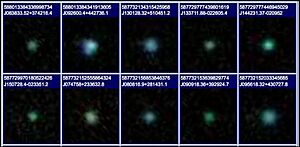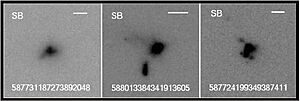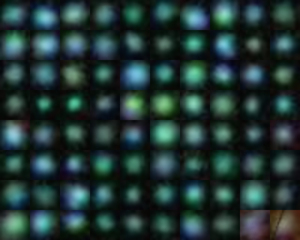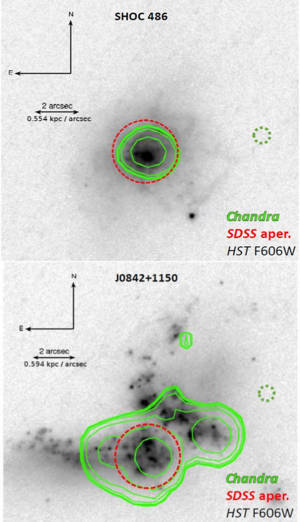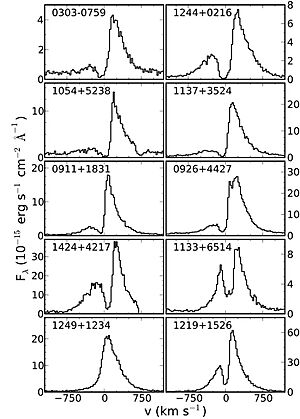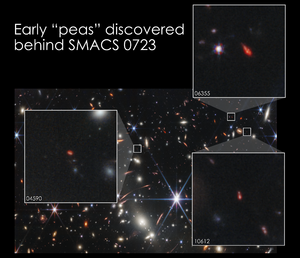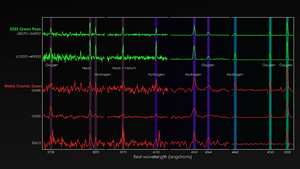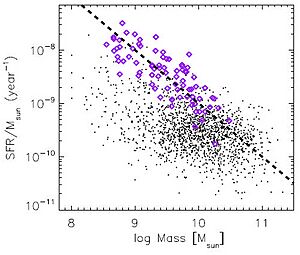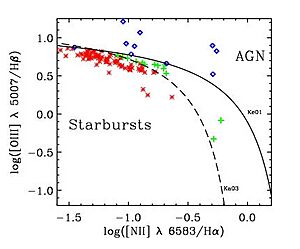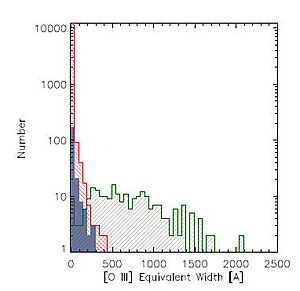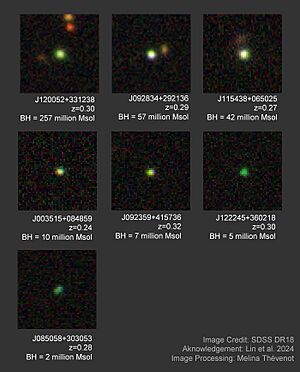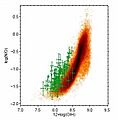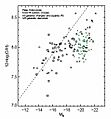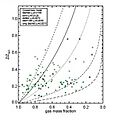Pea galaxy facts for kids
A Pea galaxy, also called a Green Pea, is a special type of small, bright blue galaxy. These galaxies are forming new stars at a very fast rate. They got their name because they look like tiny green peas in pictures taken by the Sloan Digital Sky Survey (SDSS).
Regular people, called citizen scientists, first found these "Pea" galaxies in 2007. They were helping with an online astronomy project called Galaxy Zoo. This project is part of the Zooniverse website.
Contents
What are Green Pea Galaxies?
Green Pea galaxies are small and full of oxygen. They are called "emission line galaxies" because they glow brightly with certain colors of light. Scientists found them by looking at how much their light was stretched, a process called redshift.
These low-mass galaxies are usually no bigger than 16,300 light-years across. They also tend to live in less crowded parts of space than other galaxies. An average Green Pea galaxy has a mass of about 3.2 billion solar masses. They form new stars at a rate of about 10 solar masses each year.
Green Peas glow very strongly in a specific green light from ionized oxygen. This special glow is only possible where gas is very thin. Scientists searched through many galaxy catalogs and found that Green Peas are quite rare.
These galaxies are among the smallest and most active star-forming galaxies we see today. Dr. Kevin Schawinski, an astrophysicist, said that "These galaxies would have been normal in the early Universe." Studying Green Peas helps us understand how stars formed and how galaxies grew long ago.
Green Peas existed when the universe was about three-quarters of its current age. So, they give us clues about how galaxy formation and evolution took place in the early universe. Some scientists now think that Green Peas might be older galaxies that formed most of their stars billions of years ago.
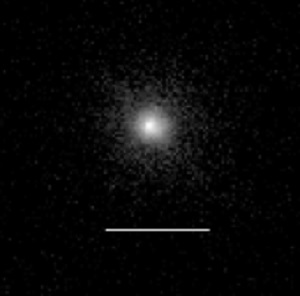
In 2016, scientists found that one Green Pea galaxy, J0925+1403, was "leaking" a special kind of light called Lyman continuum photons (LyC). This means some of its powerful light was escaping into space. Later, four more Green Peas were found to be doing the same thing.
Finding these "leaking" galaxies helps us understand how the early universe became clear after a "Dark Ages" period. The image on the right shows Pea galaxy GP_J1219, which was observed by the Hubble Space Telescope (HST).
Green Peas are also important in a project called Zoogems. This project uses the Hubble Space Telescope to look closely at interesting objects found by citizen scientists. Many Green Peas are part of this study.
How Were Green Peas Found?
Citizen Scientists Make a Discovery
The Galaxy Zoo project started in July 2007. Its goal was to have volunteers help classify a million galaxies. Just two days after the project's online forum opened, a volunteer named 'Nightblizzard' posted about two strange green objects.
Soon after, another volunteer, Hanny Van Arkel, started a discussion thread called "Give peas a chance." Many green objects were shared there. By December 2007, it was clear these unusual objects were a new type of galaxy.
These "Pea galaxies" looked like fuzzy green dots in the SDSS images. This green color comes from a very bright light given off by ionized oxygen. This light makes the "r" color band in SDSS images appear green.
Enthusiastic volunteers, who called themselves the "Peas Corps," gathered over a hundred of these galaxies. Carolin Cardamone then started a special discussion thread for them. This collection helped scientists create a computer search that found 251 Green Pea galaxies.
In 2009, scientists C. Cardamone and her team published a paper about these discoveries. They thanked 10 Galaxy Zoo volunteers for their important help. These volunteers truly "gave Peas a chance" to be discovered!
What Scientists Learned Next
After the first discovery, many scientists studied Green Pea galaxies. They wanted to learn more about their properties.
Understanding Galaxy Makeup
In 2010, R. Amorin and his team looked at the amount of heavy elements, or metallicity, in Green Peas. They found different results than the first study. They suggested that gas flowing into the galaxy, or gas pushed out by supernova explosions, might explain their findings.
Other scientists, like Y. Izotov, found that Green Peas are part of a larger group called 'Luminous Compact Galaxies' (LCGs). These are bright, small galaxies. They also found some Green Peas had very hot dust, up to 1000 Kelvin.
Scientists used powerful telescopes like the Gran Telescopio Canarias to study Green Peas even more closely. They looked for older stars hidden by the bright, new star formation. This helps them understand how these galaxies grew over time.
Studies also looked at how gases move inside Green Peas. They found that gas and stars in these galaxies can move at very high speeds, over 500 kilometers per second, relative to each other. This shows they are very active and turbulent.
Radio Signals from Green Peas
In 2012, S. Chakraborti and his team studied Green Peas using radio telescopes. They found that these young galaxies have very strong magnetic fields, even stronger than our own Milky Way galaxy. This was surprising because scientists thought galaxies built up their magnetic fields slowly over time.
More recently, in 2021, scientists detected hydrogen gas in Green Peas using radio telescopes. This helped them estimate how much atomic gas these galaxies contain.
Green Peas and the Early Universe
Leaking Light from Galaxies
In 2016, scientists confirmed that some Green Peas "leak" Lyman continuum photons (LyC). This is a very energetic type of light. This discovery is important because it helps us understand how the early universe became transparent after a period called the "Cosmic Dark Ages."
One galaxy, J0925+1403, was found to leak about 8% of its ionizing radiation. This amount is similar to what scientists think the very first galaxies in the universe did. This means Green Peas can help us study what happened billions of years ago.
These "leaking" Green Peas are like nearby examples of galaxies from the early universe. They are about 3 billion light-years away. Studying them helps us see how photons, or light particles, escape from galaxies.
Lyman Alpha Emission
In 2015, Alaina Henry and her team studied Lyman-alpha (Lyα) emission from Green Peas. Lyα is a specific type of light that helps scientists understand how galaxies form. They found that Green Peas have strong Lyα emission, just like very distant galaxies from the early universe.
This study showed that the amount of neutral hydrogen gas in a galaxy affects how much Lyα light escapes. Less neutral hydrogen means more Lyα can get out.
New Discoveries with the Webb Telescope
In 2023, the James Webb Space Telescope (JWST) found three very distant galaxies that look a lot like Green Peas. These galaxies existed when the universe was only about 700 million years old, much earlier than any Green Peas seen before.
This discovery is amazing because it suggests that these early "pea-like" galaxies might have been responsible for clearing up the early universe. They could have produced the powerful light needed to "reionize" the gas in space.
Scientists are still studying how Green Peas relate to these very early galaxies. Some research suggests that Green Peas might not be exact copies of the first galaxies because they contain older stars.
Key Features of Green Peas
Star Formation and Mergers
Early images from the Hubble Space Telescope showed that Green Peas often have bright clumps where new stars are forming. This can be a sign of recent galaxy mergers, where two galaxies combine.
Green Peas are small, like dwarf galaxies, but they form stars much faster than many other galaxies. Most Green Peas create new stars at a rate of about 3 to 30 solar masses per year.
Active Galactic Nuclei
Out of a million galaxies studied by Galaxy Zoo, only 251 were Green Peas. Scientists looked closely at 103 of them. They found that most (80) were "starburst galaxies," meaning they are rapidly forming stars.
However, some Green Peas (10 of them) showed signs of having an Active Galactic Nucleus (AGN). This means they might have a supermassive black hole at their center that is actively feeding and glowing.
Bright Oxygen Light
Green Peas are known for their very strong glow from ionized oxygen. This glow is much brighter than in most other star-forming galaxies. This strong light helps scientists identify them.
This unique brightness and low amount of dust (meaning less light is blocked) are rare in nearby galaxies. They are more common in galaxies found much further away, which means they are from an earlier time in the universe.
Green Peas also have a low amount of heavy elements, or metallicity. This is typical for small galaxies like them. Scientists use special computer programs to study the light from these galaxies.
Other Pea-like Galaxies
Blueberry Galaxies
Blueberry galaxies (BBs) are like smaller, fainter versions of Green Peas. They are very tiny dwarf galaxies that are forming stars very quickly. They have some of the lowest amounts of heavy elements and stellar mass among starburst galaxies.
Blueberry galaxies are even more compact than Green Peas, being less than 1/3000 the size of the Milky Way. They are also very young, with most being less than 70 million years old.
Scientists have found hundreds of Blueberry galaxies. They are studying how these galaxies form stars and what their environments are like.
Little Red Dots
The James Webb Space Telescope has also found a new group of small, red galaxies called Little Red Dots (LRDs). These existed between 600 million and 1.5 billion years after the Big Bang.
Scientists think these Little Red Dots might have supermassive black holes at their centers, forming Active Galactic Nuclei (AGN). Some research suggests that certain Green Peas with active black holes might be similar to these Little Red Dots.
Studying these "broad-line Green Peas" could help scientists understand the mysterious Little Red Dots and how black holes grew in the early universe.
Images for kids
See also
- Blue compact dwarf galaxy
- Dwarf galaxy
- Galaxy formation and evolution
- Green bean galaxy
- Haro 11 – One of nine galaxies shown to leak Lyman Continuum photons
- List of galaxies
- Reinventing Discovery
- Tololo 1247-232 – One of nine galaxies shown to 'leak' Lyman continuum photons
- Ultraviolet astronomy


